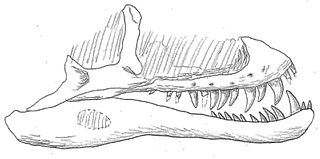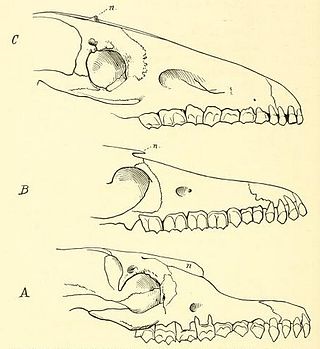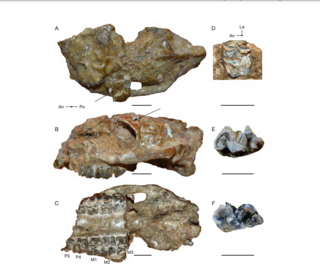
In biology, a type is a particular specimen of an organism to which the scientific name of that organism is formally associated. In other words, a type is an example that serves to anchor or centralizes the defining features of that particular taxon. In older usage, a type was a taxon rather than a specimen.

Bonitasaura is a titanosaurian dinosaur hailing from uppermost layers of the Late Cretaceous (Santonian) Bajo de la Carpa Formation, Neuquén Group of the eastern Neuquén Basin, located in Río Negro Province, Northwestern Patagonia, Argentina. The remains, consisting of a partial sub-adult skeleton jumbled in a small area of fluvial sandstone, including lower jaw with teeth, partial vertebrae series and limb bones, were described by Sebastian Apesteguía in 2004.

Trialestes is an extinct genus of Late Triassic (Carnian) crocodylomorphs that lived in South America. It has been classified as a dinosaur in the past due it being adapted as a terrestrial, running carnivore. It is classified in Sphenosuchia, which were early relatives of crocodylians. Irmis, Nesbitt and Sues (2013) noted that some of the material referred to this taxon is actually dinosaurian; however, according to the authors, the holotype specimen PVL 2561, found in the Cancha de Bochas Member of the Ischigualasto Formation in the Ischigualasto-Villa Unión Basin in northwestern Argentina, "comprises a single individual that preserves unambiguous crocodylomorph synapomorphies", indicating it is indeed a crocodylomorph, and one of the referred specimens, PVL 3889, does share one or more autapomorphies with the holotype, indicating it represents the same taxon. The type species, T. romeri, was named in 1963.

Lagerpeton is a genus of lagerpetid avemetatarsalian, comprising a single species, L. chanarensis. First described from the Chañares Formation of Argentina by A. S. Romer in 1971, Lagerpeton's anatomy is somewhat incompletely known, with fossil specimens accounting for the pelvic girdle, hindlimbs, posterior presacral, sacral and anterior caudal vertebrae. Skull and shoulder material has also been described.

Scalabrinitherium is an extinct genus of mammals of the family Macraucheniidae. Fossils of this animal were found among the fossils of prehistoric xenarthrans in the Ituzaingó Formation of Argentina.

Dromomeron is a genus of lagerpetid avemetatarsalian which lived around 220 to 211.9 ± 0.7 million years ago. The genus contains species known from Late Triassic-age rocks of the Southwestern United States and northwestern Argentina. It is described as most closely related to the earlier Lagerpeton of Argentina, but was found among remains of true dinosaurs like Chindesaurus, indicating that the first dinosaurs did not immediately replace related groups.

Psilopterus is an extinct genus of phorusrhacid from the Middle Oligocene to possibly the Late Pleistocene of Argentina and Uruguay. Compared to other phorusrhacids, members of the genus are both relatively gracile and diminutive, and include the smallest known species of terror bird: with the head raised P. bachmanni was 70–80 centimeters (2.3–2.6 ft) in height and weighed about 5 kilograms (11 lb), while the largest members of the genus were only about 8 kilograms (18 lb). The birds resemble the modern cariama, except with a heavier build and considerably smaller wings. The strong morphological similarity between the claws of the predatory cariama and Psilopterus, both of which are sharp, curved, and laterally compressed, may indicate they were used to strike prey. Tonni and Tambussi also suggested that, in contrast to the other, larger terror birds, Psilopterus could use their claws to climb trees, and could even fly, but this has been rejected in more recent literature. Fossil finds in Uruguay indicate the genus may have survived until 96,040 ± 6,300 years ago, millions of years after the larger phorusrhacids became extinct.

Thalassemys is a genus of extinct thalassochelydian turtle from the Late Jurassic of western and central Europe. While the genus was originally named by Rütimeyer in 1859 for a large carapace and other associated fragments from the late Kimmeridgian of the Reuchenette Formation of Switzerland, although the taxon was not validly named until 1873 when Rütimeyer designated the type species T. hugii. Rütimeyer also named T. gresslyi from the Reunchenette Formation in the same paper as T. hugii, but it cannot be differentiated from the type material of T. hugii and is therefore a junior synonym. A large assemblage of shell and postcranial material from the Reunchenette was named as a species of Eurysternum, E. ignoratum, by Bräm in 1965. While originally distinguished based on the presence of fontanelles on the plastron, the feature was later identified on T. hugii and E. ignoratum was designated a junior synonym. Additional material from the Kimmeridge Clay of the United Kingdom has also been referred to T. hugii.
Willinakaqe is a dubious genus of saurolophine hadrosaurid dinosaur described based on fossils from the late Cretaceous of the Río Negro Province of southern Argentina.

Quetecsaurus is a genus of titanosaurian sauropod dinosaur known from the Late Cretaceous of the southern Mendoza Province, western Argentina. It contains a single species, Quetecsaurus rusconii.

Keresdrakon is an extinct genus of azhdarchoid pterosaur from the Goio-Erê Formation of Brazil, which dates back to the Early Cretaceous period, 125 to 100.5 million years ago. Keresdrakon contains a single species, Keresdrakon vilsoni.

Dzharatitanis is a genus of sauropod from the Bissekty Formation in Uzbekistan, dating to the Turonian age of the Late Cretaceous. The genus contains a single species, Dzharatitanis kingi, named after geologist Christopher King, who contributed to the Cretaceous geology of Asia. It is currently one of two known sauropods from the Bissekty Formation, alongside an indeterminate titanosaur. In its original publication it was considered to be a member of Rebbachisauridae, but later papers considered it to be a titanosaur.
Menucocelsior is a genus of medium-sized titanosaurian sauropod dinosaur from the Late Cretaceous Allen Formation of Argentina. The type and only species is Menucocelsior arriagadai.
Sivanasua is an extinct genus of carnivorous mammal found across Miocene Europe including Germany, Austria, France, Spain and the Czech Republic. Like other lophocyonids, Sivanasua had unusual lophodont dentition, meaning the molars had ridges across the grinding surface of the molars, an adaptation believed to be indicative of a herbivorous diet.

Maip is a genus of large megaraptorid theropod dinosaur from the Late Cretaceous (Maastrichtian) Chorrillo Formation of Santa Cruz, Argentina. The genus contains a single species, M. macrothorax, known from an incomplete, disarticulated skeleton. Maip may represent the largest megaraptorid known from South America, and possibly the world.

Neobrachytherium is an extinct genus of proterotheriid mammal from the Late Miocene of Argentina and Uruguay. It is represented by multiple species, including the type N. intermedium, originally named in 1891 by Moreno and Mercerat as a species of Licaphrium, N. morenoi, originally named in 1914 by Rovereto as a species of Brachytherium, and N. ameghinoi and N. ullumense, named in 2001 by Soria, who reclassified all the species in the new genus Neobrachytherium. The various species are known from cranial and dental material from the Corral Quemado, Loma de las Tapias and Ituzaingó Formations. Neobrachytherium may be closely related to Thoatherium, Diadiaphorus and Thoatheriopsis.
Pseudobrachytherium is an extinct genus of proterotheriid from the Late Miocene of Uruguay. It is only known from the type species P. breve, named in 2020 by Corona and colleagues for an almost complete skull found in the greenish pelite of the San Pedro member of the Camacho Formation, which is Huayquerian in age. The genus name is derived from the similarity to the proterotheriid Brachytherium at first glance, with the species name from the Latin for "short", referencing the short groove on the rear of the second molars.
Dasypus neogaeus is an extinct species of armadillo, belonging to the genus Dasypus, alongside the modern nine-banded armadillo. The only known fossil is a single osteoderm, though it has been lost, that was found in the Late Miocene strata of Argentina.
Caiman australis is an extinct species of caiman described in 1858 on the basis of a left maxilla that was collected from the Upper Miocene age Ituzaingó Formation of Entre Rios, Argentina.

Ortotherium is a genus of megalonychid ground sloth from the Late Miocene Ituzaingó Formation of Entre Rios Province, Argentina. Although many species were described, the only valid species of the genus is Ortotherium laticurvatum, with many species being junior synonyms. Ortotherium is known from very fragmentary material, all of which is material from the mandible and teeth. The holotype of O. laticurvatum consists of an incomplete left dentary that had been unearthed from a series of sediments known as ‘Conglomerado osifero’ in Paraná, Argentina. Argentina paleontologist Florentino Ameghino named the species in 1885, though he would go on to name four more, invalid, species of the genus. One species however, O. brevirostrum, has been reclassified as Mesopotamocnus.






















